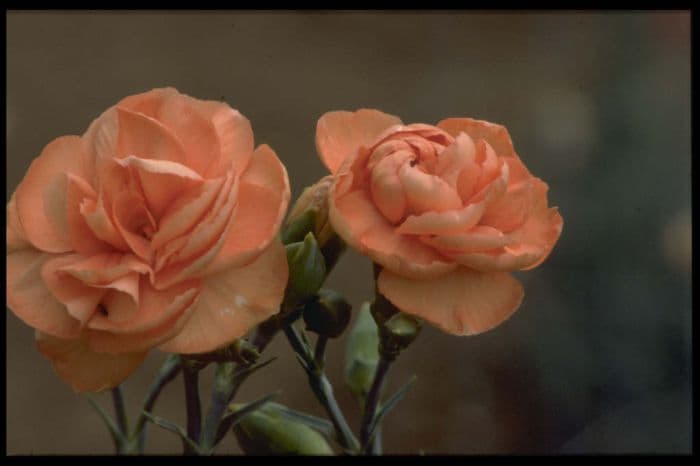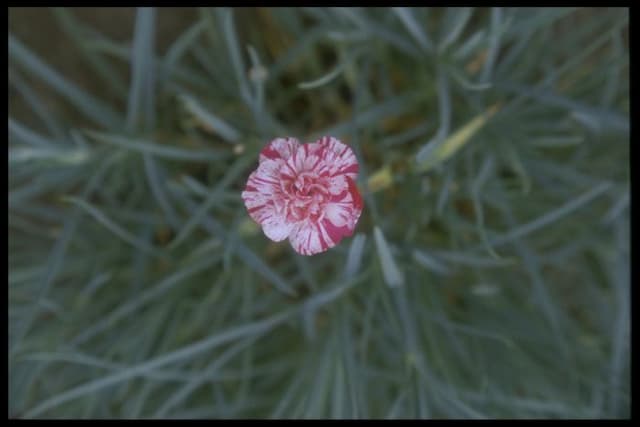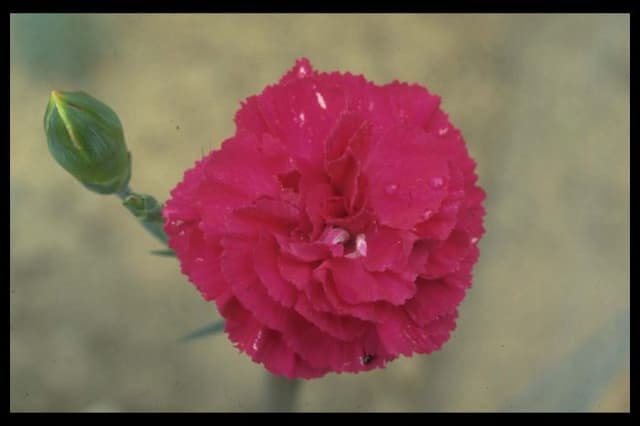Sweet William Dianthus 'Eileen O'Connor' (b)

ABOUT
Dianthus 'Eileen O'Connor' is a charming plant known for its vibrant blossoms and sweet fragrance. This plant produces a profusion of flowers with frilled edges that gracefully adorn the tips of slender stems. The petals exhibit a striking pink hue with subtle variations, ranging from soft baby pink to deep rose, often accented with a contrasting eye or ring at the center. The vivid blooms come together in attractive clusters, making them a standout in any garden. The foliage of Dianthus 'Eileen O'Connor' is equally interesting, composed of narrow, linear leaves. These leaves are typically a blue-green color, which creates a striking contrast with the brightness of the flowers. The leaves form a low-growing mound or tuft, which serves as a lush backdrop for the vivid display above. With its delightful flowers and pleasant scent, this plant is sure to attract attention and pollinators such as bees and butterflies to the garden. Its elegant foliage and showy blooms make it an excellent choice for borders, rockeries, containers, or as a vibrant spot of color in mixed beds.
About this plant
 Names
NamesFamily
Caryophyllaceae.
Synonyms
Carnation, Pinks, Sweet William.
Common names
Dianthus 'Eileen O'Connor'
 Toxicity
ToxicityTo humans
The plant commonly known as Carnation, specifically the Dianthus 'Eileen O'Connor', is not typically considered toxic to humans. However, as with many ornamental plants, sensitivity can vary from person to person. If ingested in large quantities, some individuals might experience mild gastrointestinal upset, such as nausea or diarrhea. It is always advisable to avoid eating ornamental plants as a precaution.
To pets
Carnation, including the Dianthus 'Eileen O'Connor' variety, is not known to be toxic to pets such as dogs and cats. While it's generally safe, ingestion of this plant can sometimes cause mild gastrointestinal irritation in pets, similar to humans. This could include symptoms like vomiting or diarrhea if consumed in significant amounts. It's always safe practice to prevent pets from chewing on ornamental plants to avoid any potential issues.
 Characteristics
CharacteristicsLife cycle
Perennials
Foliage type
Semi-evergreen
Color of leaves
Blue-green
Flower color
Pink
Height
1 foot 6 inches [45 cm]
Spread
1 foot [30 cm]
Plant type
Herb
Hardiness zones
5
Native area
Europe
Benefits
 General Benefits
General Benefits- Ornamental Appeal: Adds vibrant color to gardens with its brightly colored flowers.
- Extended Bloom Time: Offers a long flowering season, typically from late spring to early fall.
- Attracts Pollinators: Invites beneficial insects like bees and butterflies, promoting biodiversity.
- Drought Tolerance: Once established, it is relatively drought-resistant, requiring less frequent watering.
- Low Maintenance: Generally requires minimal care, making it suitable for gardeners of all skill levels.
- Cold Hardy: Can tolerate cooler temperatures, which makes it suitable for a variety of climates.
- Compact Growth: Its growth habit is neat and compact, ideal for borders, containers, and small gardens.
- Deer Resistance: Less appealing to deer, which can help prevent damage in areas where deer are a problem.
 Medical Properties
Medical PropertiesThis plant is not used for medical purposes.
 Air-purifying Qualities
Air-purifying QualitiesThis plant is not specifically known for air purifying qualities.
 Other Uses
Other Uses- Carnations like Dianthus 'Eileen O'Connor' can be used as a natural dye source, giving fabrics a range of soft pinks to bold reds depending on the concentration and mordant used.
- Their clove-like scent can be infused into oils or waters to create perfumes or aromatic room sprays, capturing the flower's unique fragrance.
- Pressed flowers from the Dianthus species can be incorporated into creative arts and crafts, such as making bookmarks or decorating homemade cards.
- Carnations can act as an indicator of pH balance when used in a classroom setting for science experiments, as they change color according to the acidity or alkalinity of the medium they are placed in.
- The petals can be crystallized with egg whites and sugar to create edible decorations for cakes and desserts.
- They can be used in potpourri mixes along with herbs and other dried flowers to impart a pleasant aroma to rooms or drawers.
- Plant parts can be used in creating natural insect repellents, as certain compounds found in carnations are disliked by insects.
- Dianthus flowers can be used in floral arrangements not only for aesthetics but also to keep other cut flowers fresh longer, thanks to the antibacterial properties of their stems.
- The flowers are sometimes used in the process of enfleurage to extract fragrances for high-end perfumes and scented oils.
- In the culinary world, Dianthus petals are a colorful gourmet garnish for salads, desserts, and cocktails, adding a touch of elegance and subtle flavor.
Interesting Facts
 Feng Shui
Feng ShuiThe Carnation is not used in Feng Shui practice.
 Zodiac Sign Compitability
Zodiac Sign CompitabilityThe Carnation is not used in astrology practice.
 Plant Symbolism
Plant Symbolism- Love and Admiration: Dianthus, commonly known as Carnations, often symbolizes love and admiration, with their attractive and enduring flowers representing the enduring qualities of love.
- Distinction: The name "Dianthus" comes from the Greek words "dios" (divine) and "anthos" (flower), implying divine or noble beauty and thus representing distinction and dignity.
- Pure Affection: Carnations are traditionally given as a symbol of pure affection, with different colors conveying different messages such as deep love, innocence, or rejection.
- Protection: Some believe that carnations have protective properties, and they have historically been used in garlands and wreaths to protect against evil and misfortune.
- Healing: The name 'Eileen O'Connor,' may evoke associations with nurturing and healing, reflecting the qualities of the Australian laywoman who was known for her charity work and is on the path to being recognized as a saint, and correlating with the carnation's traditional use in medicine and healing.
- Mother's Love: Carnations are also a symbol of a mother's eternal love, often worn or given on Mother's Day to show appreciation and gratitude.
 Water
WaterCarnations, including the Dianthus 'Eileen O'Connor', should be watered thoroughly, allowing the top inch of soil to dry out before the next watering. They typically require water at least once a week, but this can vary with climate conditions, being more frequent in hot, dry weather. It's best to water them early in the morning to reduce evaporation and give the foliage time to dry out, which helps prevent disease. When watering, avoid getting the foliage wet by applying water directly to the soil. Depending on the size of the plant and the weather, watering might range from half a gallon to one gallon per week during the growing season.
 Light
LightCarnations need full sun to thrive, so the Dianthus 'Eileen O'Connor' should be positioned where it can receive at least 6 hours of direct sunlight daily. The bright light helps the flowers to develop their vibrant colors and strong stems. They can tolerate some light afternoon shade, especially in very hot climates, but too much shade can lead to weak growth and fewer flowers.
 Temperature
TemperatureCarnations like the Dianthus 'Eileen O'Connor' prefer cooler climates and generally do best with daytime temperatures around 60-70 degrees Fahrenheit and night temperatures between 50-60 degrees Fahrenheit. They can tolerate temperatures as low as 40 degrees Fahrenheit and as high as 80 degrees Fahrenheit. Extended periods outside this range may inhibit blooming and can stress the plant.
 Pruning
PruningPruning is important for carnations like Dianthus 'Eileen O'Connor' to encourage bushier growth and more blooms. Pinch off the tips of the stems when the plants are young to promote branching. After flowering, deadhead spent blooms to encourage continuous blooming. Pruning should be done annually, with a more thorough cutback at the end of the blooming season to prepare the plant for winter.
 Cleaning
CleaningAs needed
 Soil
SoilCarnations like well-draining soil with organic matter, a mix of loam, peat, and sand is ideal. Maintain a soil pH of 6.0 to 7.5 for optimal growth.
 Repotting
RepottingCarnations typically need repotting every two to three years to refresh the soil and accommodate root growth.
 Humidity & Misting
Humidity & MistingCarnations thrive best in moderate humidity levels; avoid overly humid environments to prevent disease.
 Suitable locations
Suitable locationsIndoor
Place in bright indirect light and keep in cool room.
Outdoor
Full sun, shelter from strong winds, well-draining soil.
Hardiness zone
3-9 USDA
 Life cycle
Life cycleDianthus 'Eileen O'Connor' (b), commonly known as Carnation or Pink, begins its life cycle when its seeds are planted in well-draining soil and under full to partial sunlight. Germination occurs within a week or two in optimal conditions, which include regular watering and temperatures between 60-70°F (15-21°C). The seedlings develop into a rosette of leaves at the ground level, and as the plant matures, it produces long, slender stems topped with a profusion of fragrant flowers ranging from pink to red or purple, usually in late spring to early summer. Throughout the growing season, deadheading (removing spent flowers) encourages more blooms and prevents the plant from putting energy into seed production. After flowering, if seed heads are left on the plant and conditions are favorable, they may self-sow and produce new plants the following season. Perennial in nature, Dianthus 'Eileen O'Connor' typically becomes dormant in winter, surviving cold temperatures, then rejuvenates and starts its cycle anew in the spring.
 Propogation
PropogationPropogation time
Spring-Early Summer
Dianthus 'Eileen O'Connor', commonly known as Pink, is best propagated through stem cuttings, particularly during late spring or early summer when the plant's growth is most vigorous. To propagate Pinks via cuttings, select healthy, non-flowering stems about 3 to 5 inches long and cut just below a node. Remove the lower leaves and dip the cut end into rooting hormone powder to encourage root growth. Plant the cuttings into a well-draining soil mix, ensuring at least two nodes are beneath the soil surface. Keep the soil moist but not waterlogged, and place the cuttings in a warm spot with indirect light. Rooting typically occurs within a few weeks, after which the new plants can be gradually acclimatized to outdoor conditions before transplanting.






![Pink [Coconut Sundae]](/_next/image?url=https%3A%2F%2Fplants-admin.emdemapps.com%2Fimages%2Fplants%2F%2Fimages%2F604b5d09d4fd1.png&w=640&q=75)


